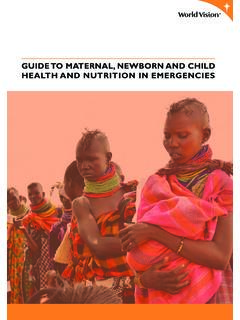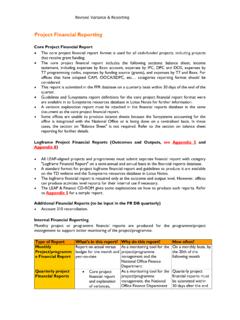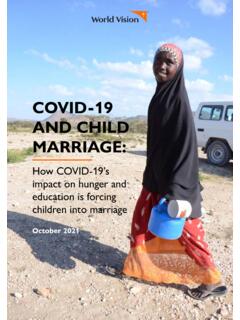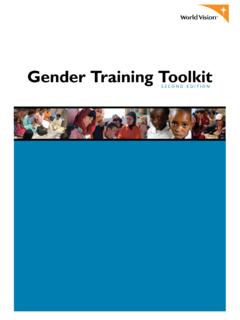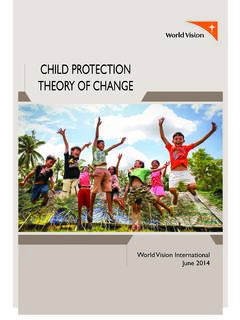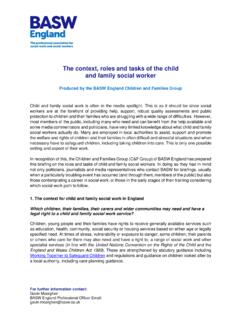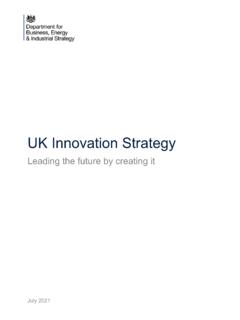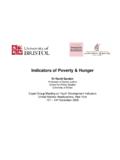Transcription of The Handbook for Development Programmes
1 The Handbook forDevelopment ProgrammesThe EssentialsWorld Vision International, 800 West Chestnut Avenue, Monrovia, California 91016-3198 World Vision International rights reserved. No portion of this publication may be reproduced in any form, except for brief excerpts in reviews, without prior permission of the Managed by: Jeremy BaileyInterior Design and Layout: Teresa WallaceCover Design: WVI Global Creative ServicesIllustrations by Ron Wheeler at by StepFilms and Media, LLCP roduction Management: Katie Klopman, Ann AbrahamCopyediting: Joan LaflammeProofreading: Audrey DorschPublished by Integrated Programming Effectiveness on behalf of World Vision InternationalWorld Vision is a Christian relief, Development , and advocacy organisation dedicated to working with children, families, and communities to overcome poverty and followers of Jesus, World Vision is dedicated to working with the world s most vulnerable people. World Vision serves all people regardless of religion, race, ethnicity, or Handbook is based on good practices and learning from staff across the World Vision Partnership.
2 We especially want to acknowledge the staff of national offices and Programmes that helped develop, pilot and adopt the integrated programming model. We deeply respect their passion, creativity and commitment to strengthening WV s Development are grateful to all staff who provided comments on earlier versions of this Handbook including local programme staff and staff from national, regional and support offices. We appreciate the active engagement of the Global Operations Leadership Team. We are grateful to the technical specialists in the regions, Global Centre, and support offices who contributed to the Development of this Handbook . Colleagues in Children in Ministry and Integrated Programming Effectiveness deserve special recognition for their contributions. Finally, we want to thank the team that has led Development of the set of resource materials of which this Handbook is a part: Seamus Anderson, Jeremy Bailey and Teresa Wallace. We appreciate all their hard work and dedication in developing user-friendly materials that equip WV staff to work effectively with communities and partners toward the sustained well-being of children especially the most Casey and Mark LoreyIntegrated MinistryWorld Vision InternationalAcknowledgements1.
3 Introduction ..42. Background: World Vision Essentials ..53. What Is WV s Development programme Approach? ..6 Programming Effectiveness Standards.. 8 Contributing towards child well-being ..9 Working with partners ..14 Equipping local level staff ..19 Basic programme parameters ..214. Putting WV s Development programme Approach Into Action ..25 Overview of the Critical Path ..25 LEAP and the Critical Path ..28 Project models and ADAPTs ..29 Action learning ..30 Appendix: Steps of the Critical Path ..31 ContentsAcronymsFigure 1. Overview of the Guidance for Development Programmes ..4 Figure 2. The World Vision Ministry Framework ..5 Figure 3. World Vision s Integrated Focus ..5 Figure 4. World Vision s Principle-Level Choices ..6 Figure 5. Four main aspects of WV s Development programme Approach ..7 Figure 6. The child well-being aspirations and outcomes ..10 Figure 7. Sponsorship Minimum Programming Standards and child well-being targets ..11 Figure 8.
4 Options for collaboration ..16 Figure 9. Staffing structure ..19 Figure 10. programme impact area and primary focus areas ..22 Figure 11. The Critical Path ..25 Figure 12. The four stages of the Critical Path ..27 Figure 13. LEAP and the Critical Path ..28 Figure 14. Shared programme ..29 ADAPT .. analysis, design and planning toolCBO .. community-based organisationCMS .. Child Monitoring StandardDF .. Development facilitatorDME .. design, monitoring and evalutionFBO .. faith-based organisationGDP .. Guidance for Development ProgrammesICD .. Integrated Competency DevelopmentIPM .. Integrated Programming ModelLEAP .. Learning through Evaluation with Accountibility and Planning NGO .. non-governmental organisationNO .. national officePDD .. programme Design DocumentRC .. registered childrenSMPS .. Sponsorship Minimum Programming StandardsWV .. World Vision4 WORLD VISION S Handbook FOR Development PROGRAMMESI ntroductionThis Handbook describes the essentials of WV s Development programme Approach.
5 The focus of this approach is equipping local-level staff to work effectively with communities and partners towards the sustained well-being of children, especially the most vulnerable. The approach serves as a vehicle to integrate and focus WV s Development Programmes on child well-being priorities including the child well-being targets in the WV national office strategy. WV s Development programme Approach is built on good practices from many WV offices and Programmes , as well as learning from other organisations. It reflects and enables continuous improvement of WV s Development practice. The essentials of the approach should be applied flexibly in context, based on a national office s experience and learning. This Handbook is designed for use by World Vision staff who seek to understand and apply the approach. The Handbook has three parts:1. Background: World Vision Essentials2. What Is WV s Development programme Approach?3. Putting WV s Development programme Approach into ActionThe Handbook can be used by Programmes with sponsorship and Programmes using grant Handbook is part of World Vision s Guidance for Development Programmes (GDP), an integrated set of resource materials available to support World Vision Development - programme staff as needed.
6 The Handbook provides links to other resource materials that can provide further information and help to WV brings together a range of tools and reference documents from different parts of World Vision into a flexible set of mutually reinforcing pieces. The parts of World Vision s ministry integrated in GDP include Learning through Evaluation with Accountability and Planning (LEAP), child sponsorship, Christian commitments, disaster management, local advocacy, sectors, and 1. Overview of the Guidance for Development ProgrammesGDP is available online at: Its contents can be downloaded and saved on a computer or other portable VISION S Handbook FOR Development PROGRAMMESB ackground: World Vision EssentialsThe World Vision Ministry FrameworkWorld Vision s Ministry Framework is the starting point for all WV programming. The Ministry Framework builds on WV foundational documents and integrates all areas of WV s ministry.
7 It brings clarity to WV s understanding of poverty, inequity and vulnerability, and to our response. All WV Programmes and projects are designed according to their context. Each contributes to the Ministry Framework s goal:Sustained well-being of children within families and communities,especially the most framework s goal, aspirations, approaches and principles are illustrated in Figure 2. The World Vision Ministry FrameworkIntegrated Focus means that in all places where WV works, staff appropriately express their Christian identity, prioritise children, and walk alongside communities and partners who are rooted in the principles and approaches of the Ministry Framework describe vital elements that need to be in place in order to achieve the ministry goal. The principles reflect WV s commitment to the rights of children, the responsibilities of adults, and the way in which WV staff work with others. The approaches describe the way WV puts these principles into practice.
8 They reflect WV s Integrated Focus and Principle-Level Choices (see Figure 3 and Figure 4).Figure 3. World Vision s Integrated Focus6 WORLD VISION S Handbook FOR Development PROGRAMMESThe WV Ministry Framework, the Integrated Focus, and the Principle-Level Choices documents can be found in the reference materials on the GDP website: Principle-Level Choices guide the Development of strategies that tackle the root causes of poverty, inequity and vulnerability in ways that empower communities and local stakeholders. These choices are driven by local needs and maintain the multiple ministries of relief, Development and is WV s Development programme Approach?OverviewThe purpose of WV s Development programme Approach can be summarised in a single sentence:Equip WV local level staff to work effectively with partners towards the sustained well-being of children within families and communities, especially the most approach reflects and supports continuous improvement of WV s Development practice in contributing to child well-being especially the WV child well-being targets.
9 The approach enables WV Programmes to put the Ministry Framework and national office ministry priorities into action in WV s Development s Development programme Approach is rooted in decades of WV experience with transformational Development . It integrates advocacy, disaster management, Christian commitments and all other parts of WV s ministry. This integration is done in a way that is appropriate to each context, building on local assets and existing efforts towards child well-being. Formerly called the Integrated Programming Model (IPM), WV s Development programme Approach has emerged from a process of co-creation involving staff across WV, with special emphasis on local level staff. It is based on good practices and learning from many Programmes and offices within WV and from many other organisations. The approach is flexible and is applied innovatively based on context. It continues to evolve based on learnings from Programmes and offices applying Value of WV s Development programme ApproachWV s Development programme Approach focuses WV s Programmes on contributing to sustained well-being of children, including WV s child well-being targets, and thus is a key vehicle helping a national office put its strategy into action brings together good practices in WV s ministry, including Development , disaster management, advocacy, Christian commitments, sectors, and design, monitoring and evaluation (DME) integrates sponsorship as a core part of programming in Programmes with sponsorship.
10 Empowers communities and local stakeholders to work together towards child well-being, building the local leadership and ownership essential for sustainability supports effective participation of children and youth in efforts to improve child well-being in the short term and the long term embeds learning throughout the programming process, building on and integrating 4. World Vision s Principle-Level Choices7 WORLD VISION S Handbook FOR Development PROGRAMMESWhat is WV s Development programme Approach?Figure 5. Four main aspects of WV s Development programme Approach Commitment to Sustainability The Four Main Aspects of WV s Development programme ApproachA commitment to sustainability was one of the major factors driving Development of WV s Development programme Approach. In collaboration with communities and partners, WV contributes to the sustained well-being of children by working at four levels:Children: empowering children, especially the most vulnerable, with good health, spiritual nurture, and basic abilities and skills (including literacy, numeracy and essential life skills) that will enable them to be productive, contributing citizens and agents of change throughout their and families: improving household resilience, livelihood capacity and caregiving capacity.


